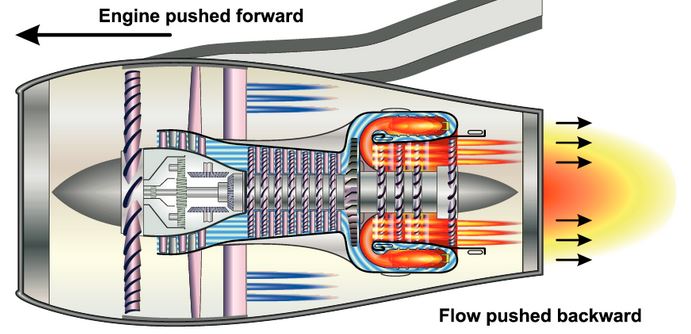
Image: Aviation Stack Exchange
You have probably witnessed a jet of fluid, whether it’s water or air, coming out of a pipe, under pressure. If you are holding the pipe, you would feel a force in the in the opposite direction of the fluid exiting the pipe. What you’re experiencing is Newton’s third law – for every action there is an equal and opposite reaction – jet of fluid in the rearward direction produces a force or thrust in the forward direction.
This is quite simply, the basic principle of how the jet engine works. The more powerful the jet rearward, the more thrust (forward force) is produced.
The way the jet in an aircraft jet engine is produced is quite simple. Combustion, the process of burning, by chemical reaction converts a mix of fuel (hydrocarbon) and Oxygen to Carbon Dioxide and Carbon. Heat is released and heats up the gases which tend to expand and then cool. Since everyone already knows about the Stochiometric ratio for efficient combustion, we will simply remind you, that it refers to the ideal fuel to air ratio.
If you contain the combustion within an open ended canister, the shape being such that it has a big opening side (high pressure) and a small opening side (low pressure), the expanding hot gases will be jetted out in the path of lowest resistance (low pressure) to the surrounding atmosphere. The canister then will tend to move forward. You will notice that the rear of the jet engine has a small opening at the back, and a large one in the front!
To increase the thrust (forward force), the amount, and speed, of gas jetting out of the rear must be increased. This is achieved by increasing the mass of the air, and fuel for combustion. Increasing the amount of fuel is easy, however, to increasing the mass of air for combustion can be done in a number ways.
The simplest, is for the engine to propel itself at a higher forward speed. Obviously, the more gas mass that enters the engine, the more thrust is generated! The faster the engine moves, the better it performs. From the forward airspeed, air is compressed in the intake, and this is ideal for further combustion.
This engine works best at very high speed, with highly compressed air in the front, fuel/air inside, a jet of super-fast gas out of the back, and no moving parts! However, the slower it goes, the worse it performs. So much so, that it becomes impractical for civil aviation. See Pulse Jet, Ram Jet, Scram Jet engines as examples.
It is evident that compressed air together with the right air/fuel ratio is needed under all conditions.
To achieve this, an air compressor is added inside the engine. This compressor needs to be mechanically driven. To obtain this drive, a turbine is inserted at the rear of the engine, just behind the combustion chamber, and in front of the jet pipe (opening to the back end). The way a turbine works is simple. The hot jet of gas is directed onto the blades that are situated at the perimeter turbine. This turbine now turns, like a windmill, only faster! The turning turbine is connected to the compressor by means of a shaft. So, the higher the speed of jet gas directed onto the turbine blades, the faster it will spin, and therefore the faster the compressor will spin, which obviously will compress more. This is what forms a Turbo Jet or Turbine engine.
Now, the new turbine or turbojet can be efficiently used for both high and low speed. These engines may have more than one turbine driving more than one compressor.
Variants of these jet engines are as follows:
Turbojet – turbine/s coupled to compressor/s
Turbofan – one of the turbines is coupled to a high speed fan situated at the front of the engine, this produces the most thrust.
Turboprop – one of the turbines is coupled to a reduction gearbox that drives a propeller situated at the front of the engine
Turbo shaft – one of the turbines is coupled to a reduction gearbox, which can drive another machine or helicopter rotor blades for example.
The turbine jet engine is now the most commonly used aircraft engine in civil aviation.
In summary, the working of the turbojet engine:
- Air enters the Turbojet engine at the air intake.
- Air gets compressed by a spinning compressor that is driven by a turbine.
- The compressed air enters the combustion chamber, fuel is added
- Combustion takes place
- Hot and high speed jets towards the rear of the engine
- The gas is directed onto the turbine blades
- The turbine spins which in turn spins the compressor
- The high speed hot jet of gas escapes the engine at the rear via the jet pipe.
- The action of this gas escaping towards at the rear, causes a reaction (thrust) in the opposite direction.
Newton’s third law!



